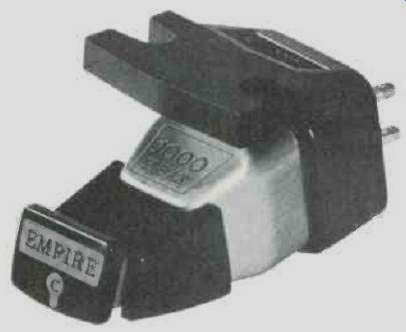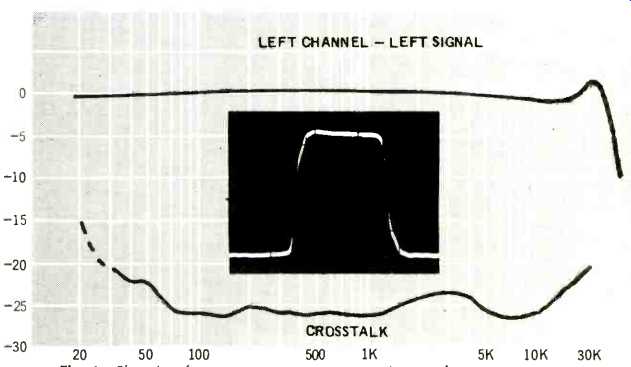
MANUFACTURER'S SPECIFICATIONS:
Frequency Response: 4 to 40,000 Hz.
Output Voltage: 5.0 mV; Channel Separation: 35 dB; Tracking Force: 1/4 to 1 1/4 gms.; Stylus Tip Size: 0.2 x 0.7 mils; Weight: 7 gms; Price: $99.95.
Phonograph cartridges are getting more and more expensive-and at the same time, better. The 1000 ZE is the top-of the-line model of the Empire line, which ranges in price down to $24.95 for the lowest priced conical-stylus unit. There are many good cartridges on the market, and most of them will give satisfactory performance on average equipment. It is when every other element in the reproduction chain is of the highest quality that performance differences between cartridges become apparent. The 1000 ZE has a user-replaceable stylus, protected by a hinged cover so you don't have to worry about damaging the stylus when you take it down to the dealer's to check the stylus tip-and for this transporting, we recommend a 35-mm film can, with possibly a few layers of paper rolled inside to fill up the voids.
The cartridge consists of four coils, disposed 90 deg. apart and wired so as to be hum-bucking to any external fields. The two pairs of coils are each wired in series to give this effect. The cores of the four coils are brought out to four equally spaced pole pieces, and two magnets are placed so as to induce fields which are varied by movement of the stylus "bar." ( The term "bar" is used since it is the usual term used to describe the structure on which the stylus is mounted, but when the bar is a hollow tube one thousandth of an inch thick, the word is hardly appropriate.)
The armature, integral with the stylus bar, moves within the fields of the four pole pieces. It is the third of the three magnets in the cartridge. Technically, each pair of coils has a d.c. resistance of 1170 ohms and an inductance of 700 mil, and each channel-consisting of two coils--is designed to work into the usual load of 47,000 ohms found in most preamps, integrated amplifiers, and receivers. Output signal from each channel measured at 1.18 mV/cm/sec. ( which means 1.18 millivolts for a stylus velocity of 1 centimeter per second). The figure of 5.0 mV in the specifications is not shown relative to any particular stylus velocity, but is presumed to be at the standard velocity of 3.54 cm/sec for stereo grooves, or 5.0 cm/sec for mono. We actually measured an output of 4.2 mV for a stylus velocity of 3.54 cm/sec, and for comparison purposes we converted it to the output in mV/cm/sec.
The entire cartridge structure is molded in plastic, then covered with a mu-metal shield to further eliminate the effect of external hum fields, of which there are likely to be many around phonograph motors and in proximity to power transformers in receivers and amplifiers. Frequency response measurements were made on the cartridge with a continuous curve-plotting instrument, and results are shown in Fig. 1. The CBS STR-100 record was used, covering the range from 40 to 20,000 Hz. The range from 500 to 50,000 was obtained in a sweep from the CBS Wide Range Pickup Test Record, and outputs below 40 Hz were obtained from the frequency-step section of the invaluable STR-100. Crosstalk measurements were also made with the same record over the range from 40 to 20,000 Hz. Square-wave photos, made from CBS STR-100, are shown in Fig. 1. For these photos, the pickup was fed into a Dynaco SCA-80.
Response was found to be within ±0.5 dB from 20 to 6000 Hz, drooping to -1 dB at 15,000, then rising to a big peak of 1.5 dB at 21,000 Hz, then dropping off to 10 dB down at 30,000 Hz. Measured crosstalk ranged from 15 dB at 20 Hz to 26 dB at 100 Hz and remaining in that vicinity past 10,000 Hz, when it began to decrease, reaching a separation of 20 dB at 20,000 Hz. Both channels were as nearly identical as possible-at least well within 0.5 dB.

Fig. 1--Showing frequency response, separation, and square wave.
Using the CBS STR-110 record to check IM distortion, we came up with 1.8 per cent for the +9 dB level of lateral IM signal consisting of 200 and 4000 Hz, and a figure of 6.6 per cent for vertical 200/4000 at +6-the two conditions we have selected to use as standards. Since there are five bands of 200/4000 lateral, five bands of 400/4000 lateral, and three bands of vertical IM signals-all at different levels, we do not feel that space would permit listing all.
While the measurements would satisfy any group of test equipment, the real test is in listening, and here we were agreeably surprised-the listening proved that instruments don't lie. While we can't claim that we played every record in our fair-sized collection, we do claim that we played about thirty of the ones we usually break out for cartridge tests. Reproduction was exceptionally clean, with good separation and the kind of clarity one always hopes for. Smooth clean strings, crisp brasses, and solid lows were all evident throughout the listening. Separation was most evident in choral material and in our favorite opera recording-the Angel "Bartered Bride." Tracking was consistent on the 598 as low as K gram, although it took the more common 1-gram stylus force on another turntable for reliable operation.
Like they say: you are apt to get what you pay for--and if your budget will stand for the cost of a 1000 ZE, we suggest you try it. And again, ungrammatically, like they say in discount-store ads, "You'll be glad you did."
-C.G.McP.
(Audio magazine, Nov 1970)
Also see:
Empire 600 LAC Phono Cartridge (Jun. 1982)
Empire EDR.9 Magnetic Phono Cartridge (Equip. Profile, Sept. 1979)
Empire Scientific EDR.9 phono cartridge (ad, Sept. 1979)
Empire Scientific phono cartridges (ad, Nov. 1978)
= = = =